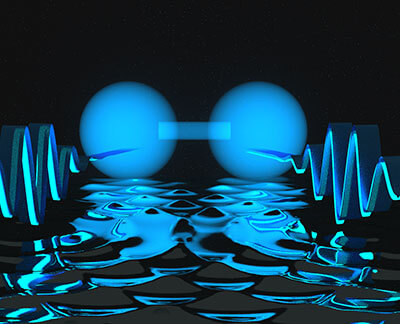Physicists from the US National Institute of Standards and Technology (NIST) have taken another step towards the development of objects composed of photons, with the findings suggesting that weightless particles of light may bond together to form a type of molecule with its own unique properties.

[Translation by Dr. Nachmani Moshe]
Physicists from the US National Institute of Standards and Technology (NIST) have advanced another step towards the development of objects composed of photons, with the findings suggesting that weightless particles of light may join together to form a type of molecule with its own unique properties.
In 2013, a joint team of researchers from Harvard, Caltech and MIT universities found a way to couple two photons together so that one "rides" right over the other photon as it moves. The findings of this experiment were considered ground-breaking, since no one had previously thought of creating anything by combining individual photons. Now, in an article published in the scientific journal Physical Review Letters, a team of researchers from the University of Maryland and the National Institute of Standards and Technology in the US have shown, theoretically, that by changing a number of the parameters underlying the connection process, photons can move side by side, at a specified distance from each other. This spatial arrangement is similar to the spatial arrangement of two hydrogen atoms that together form a diatomic hydrogen molecule.
"The structure we found is not that of an actual molecule, but it can be imagined as having a similar type of structure," said one of the researchers. "We are learning how to build complex light conditions, which in turn, can create more complex objects. This is the first time someone has shown how it is possible to connect two photons that are at a fixed distance from each other."
Despite the potential promise of the new discovery, the researchers note that the day when we can use a lightsaber in our daily lives is still far off. The main reason for this lies in the fact that the connection of photons requires extreme conditions that exist only in laboratories where extremely advanced equipment is used. And yet, this field of research holds tremendous potential - "many of the modern technologies are based on light, starting with communication technologies and ending with high-resolution imaging methods", explains the researcher. "Many of these methods can be improved if we manage to find the way to generate defined interactions between individual photons."
For example, engineers need to find a way to perform a very precise calibration of light meters, and the researcher claims that their findings could help create a "standard candle" that could shine a fixed and defined number of photons towards a detector. And perhaps more importantly for the computer industry, connecting and interweaving photons could allow computers to utilize photons as information processors, a function that is carried out today with the help of electronic switches found in computers.
The new findings could not only provide a new basis for creating improved computers, but they could also lead to significant energy savings. Telephone messages and other data are currently transmitted as light beams through cables consisting of optical fibers and need to be converted to electrons for processing - this is an inefficient step during which a considerable amount of electricity is wasted. If it would be possible to carry out both the transfer phase and the processing phase of the information directly with the help of photons, then this waste of energy would disappear. The main researcher explains: "This is a new and fascinating way to examine the behavior of photons." Photons are massless particles that travel at the speed of light. Slowing down the speed of their movement and connecting them together may reveal other things to us that we don't even think about yet."

3 תגובות
Joseph
Photons are not the only particles that transfer energy and momentum. Think of gravity for example.
The article is very interesting. Photons are particles that carry energy and power. The interaction between particles in quantum theory is carried out with them. I never thought of them as anything other than energy packs. The idea that they can maintain a stable connection without being inside a coupler or interact with each other without a coupler - is unknown to me.
Fans of science - I call on all of us to create comment chains. This is one of the smartest sites on the Israeli web, if not the smartest of them all, and it's free. Is that why the amount of talkbacks is low?